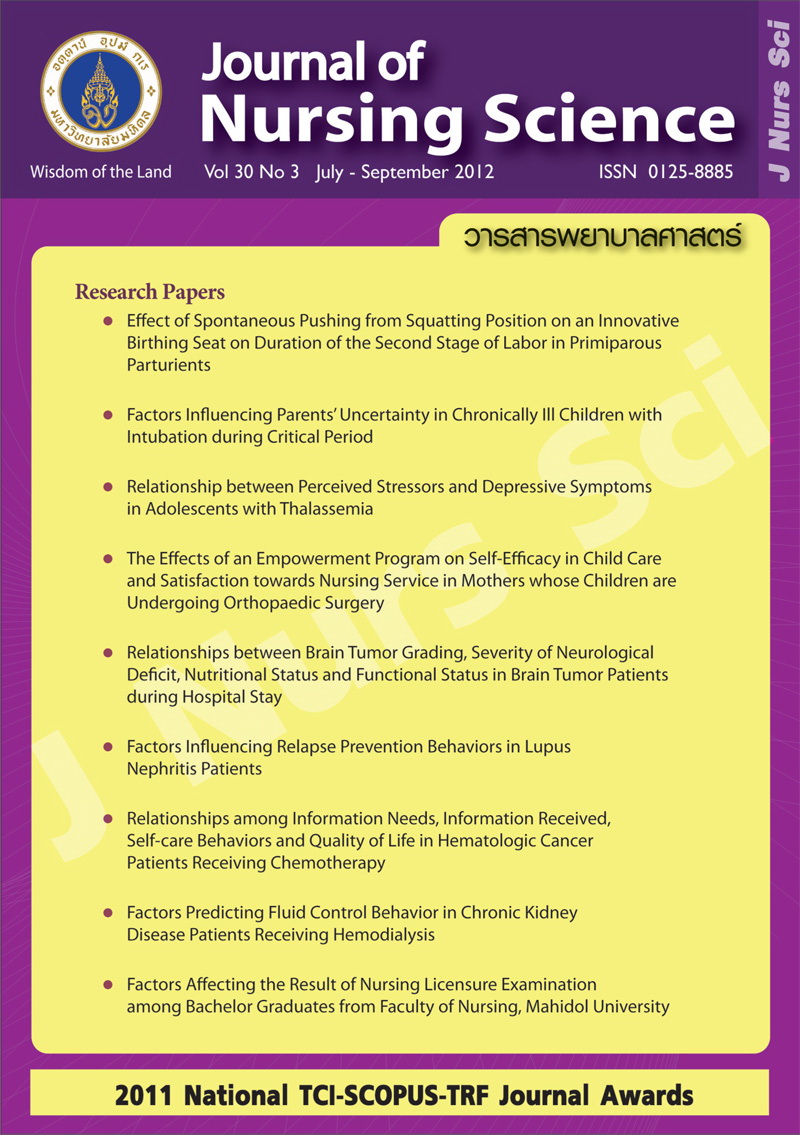Factors Predicting Fluid Control Behavior in Chronic Kidney Disease Patients Receiving Hemodialysis
Main Article Content
Abstract
Purpose: To examine the predictive power of age, education level, income, duration of hemodialysis treatment, perceived self-efficacy, and outcome expectancy on fluid control behavior of patients with chronic kidney disease receiving hemodialysis.
Design: Correlative predictive study.
Methods: The participants were 98 patients receiving hemodialysis at the Hemodialysis Unit of the Kidney Foundation of Thailand, Priest Hospital. The eligible patients had to be on hemodialysis twice a week for at least 6 months. Data were collected using interviewing questionnaires: 1) the personal data
questionnaire 2) the perceived self-efficacy in fluid control scale 3) the outcome expectancy scale and 4) the fluid control behavior scale. Descriptive statistics and multiple regressions were used to analyze the data.
Main findings: The result indicated that the sample had overall fluid control behaviors at a medium level. The study variables including age, income, education level, duration of hemodialysis treatment, perceived self-efficacy, and outcome expectancy could explain 43.2% (R2 = .432, p < .05) of the variance in fluid control behavior. Perceived self-efficacy and income could significantly predict fluid control behavior at the statistically significant level .05.
Conclusion and recommendations: Nurses who take care of patients receiving hemodialysis should develop a program to promote a perceived self-efficacy in fluid control behavior. In addition, patients’ income should be taken into consideration when tailoring the program to ensure the patients’ compliance resulting in effective fluid control behavior.
บทคัดย่อ
วัตถุประสงค์: เพื่อศึกษาอำนาจการทำนายของอายุ ระดับการศึกษา รายได้ ระยะเวลาที่ได้รับการรักษาด้วยการฟอกเลือดด้วยเครื่องไตเทียม การรับรู้สมรรถนะของตนเอง และความคาดหวังผลลัพธ์ต่อพฤติกรรมการจำกัดน้ำในผู้ป่วยโรคไตเรื้อรังที่ได้รับการรักษาด้วยการฟอกเลือดด้วยเครื่องไตเทียม
รูปแบบการวิจัย: การศึกษาความสัมพันธ์เชิงทำนาย
วิธีดำเนินการวิจัย: กลุ่มตัวอย่างเป็นผู้ป่วยโรคไตเรื้อรัง ที่ได้รับการรักษาด้วยการฟอกเลือดด้วยเครื่องไตเทียม ที่มารับการฟอกเลือดที่หน่วยไตเทียมมูลนิธิโรคไต โรงพยาบาลสงฆ์ โดยมีเกณฑ์การคัดเลือกดังนี้ เป็นผู้ป่วยได้รับการฟอกเลือดด้วยเครื่องไตเทียมจำนวน 2 ครั้งต่อสัปดาห์ มาแล้วเป็นระยะเวลาไม่น้อยกว่า 6 เดือน โดยคำนวณกลุ่มตัวอย่างได้จำนวน 98 คน เก็บข้อมูลโดยใช้เครื่องมือวิจัย 4 ชุดคือ 1) แบบบันทึกข้อมูลส่วนบุคคล 2) แบบประเมินการรับรู้สมรรถนะของตนเองต่อพฤติกรรมการจำกัดน้ำ 3) แบบประเมินความคาดหวังผลลัพธ์ต่อพฤติกรรมการจำกัดน้ำ และ 4) แบบประเมินพฤติกรรมการจำกัดน้ำของผู้ป่วย
โรคไตเรื้อรังที่ได้รับการรักษาด้วยการฟอกเลือดด้วยเครื่องไตเทียมวิเคราะห์ข้อมูลโดยสถิติเชิงพรรณนา และวิเคราะห์ความสามารถในการทำนายโดยวิธีวิเคราะห์ความถดถอยเชิงพหุ
ผลการวิจัย: พบว่าระดับพฤติกรรมการจำกัดน้ำโดยรวมอยู่ในระดับปานกลาง อายุ รายได้ ระดับการศึกษา ระยะเวลาที่ได้รับการรักษาด้วยการฟอกเลือดด้วยเครื่องไตเทียม การรับรู้สมรรถนะของตนเองและความคาดหวังผลลัพธ์ สามารถร่วมกันทำนายพฤติกรรมการจำกัดน้ำของผู้ป่วยได้ร้อยละ 43.2 (R2 = .432, p < .05) โดยพบว่า การรับรู้สมรรถนะของตนเองต่อพฤติกรรมการจำกัดน้ำและรายได้ สามารถทำนายพฤติกรรมการจำกัดน้ำของผู้ป่วยโรคไตเรื้อรังที่ได้รับการรักษาด้วยการฟอกเลือดด้วยเครื่องไตเทียมได้อย่างมีนัยสำคัญทางสถิติที่ระดับ .05
สรุปและข้อเสนอแนะ: พยาบาลผู้ดูแลผู้ป่วยที่ฟอกเลือดด้วยเครื่องไตเทียมควรมีการพัฒนากิจกรรม หรือโปรแกรมเพื่อส่งเสริมให้ผู้ป่วยมีการรับรู้สมรรถนะของตนเองต่อพฤติกรรมการจำกัดน้ำมากขึ้น และควรคำนึงถึงรายได้ที่แตกต่างกันของผู้ป่วยด้วยในการจัดรูปแบบโปรแกรม ทั้งนี้เพื่อให้ผู้ป่วยสามารถปฏิบัติตามได้ ส่งผลให้เกิดพฤติกรรมการจำกัดน้ำที่ดีขึ้น
คำสำคัญ: โรคไตเรื้อรัง ปัจจัยทำนาย พฤติกรรมการจำกัดน้ำ การฟอกเลือดด้วยเครื่องไตเทียม
Article Details
Copyright Notice: Nursing Science Journal of Thailand has exclusive rights to publish and distribute the manuscript and all contents therein. Without the journal’s permission, the dissemination of the manuscript in another journal or online, and the reproduction of the manuscript for non-educational purpose are prohibited.

Disclaimer: The opinion expressed and figures provided in this journal, NSJT, are the sole responsibility of the authors. The editorial board bears no responsibility in this regard.


